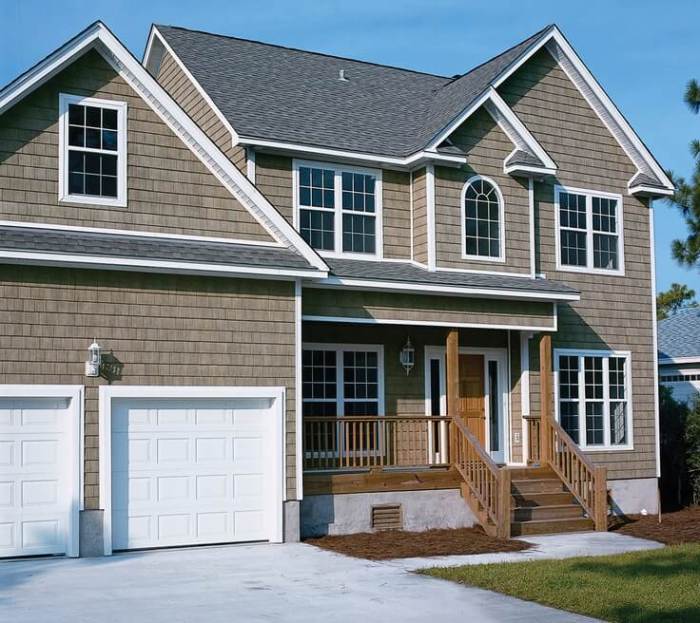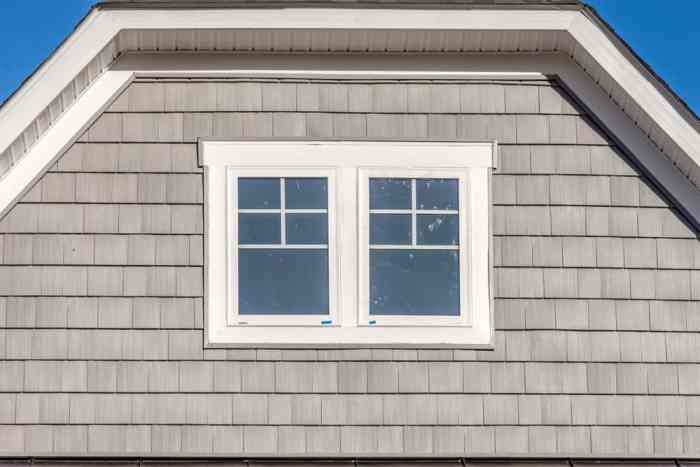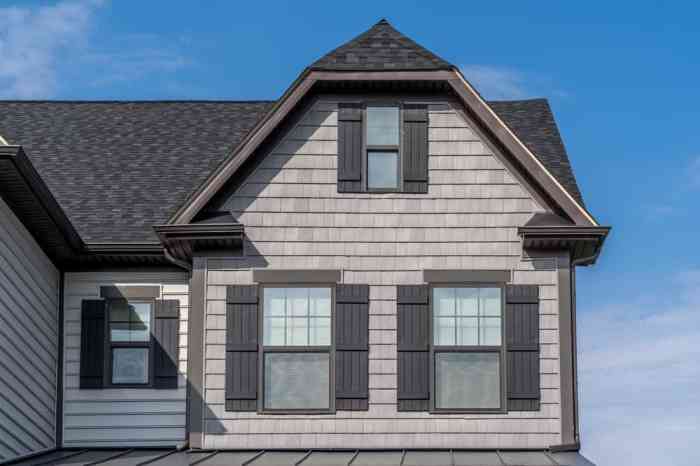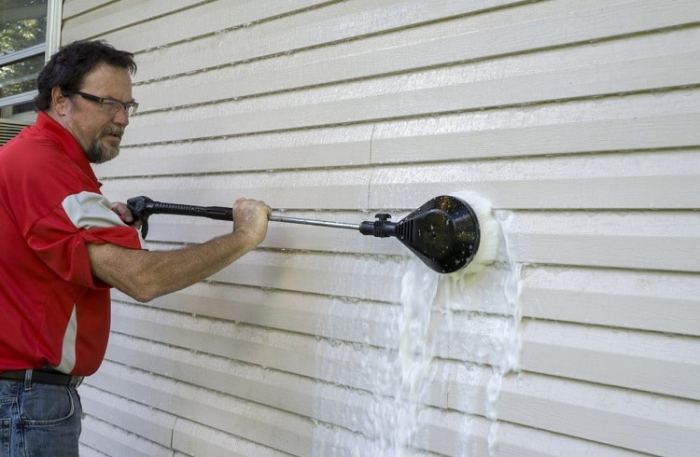Vinyl shake siding cost is a crucial factor to consider when upgrading your home’s exterior. This guide delves into the various aspects influencing the overall expense, from material selection and labor costs to the complexities of installation and long-term maintenance. Understanding these factors empowers you to make informed decisions, ensuring a cost-effective and aesthetically pleasing outcome for your home improvement project. We’ll explore the price ranges, compare vinyl shake siding to other options, and provide tips for finding affordable solutions and reputable contractors.
We’ll break down the costs associated with materials versus labor, offering a realistic budget framework. Furthermore, we’ll examine the potential savings and risks involved in DIY versus professional installation, equipping you with the knowledge to choose the best approach for your skills and resources. Finally, we’ll discuss the long-term implications, including maintenance and potential repair costs, to provide a holistic view of the total cost of ownership.
Average Vinyl Shake Siding Costs
Vinyl shake siding offers a durable and aesthetically pleasing alternative to traditional wood shake, providing a similar look with lower maintenance requirements. Understanding the cost involved is crucial for homeowners planning a siding replacement or new construction project. This section details average costs and factors influencing price variations.
Vinyl Shake Siding Cost Range
The average cost of vinyl shake siding installation ranges from $7 to $15 per square foot. This price encompasses both the material and labor costs. The lower end of the spectrum typically reflects projects using less expensive vinyl and simpler installations, while the higher end accounts for premium vinyl with added features like realistic wood grain textures and more complex installation scenarios, such as those involving significant repairs or unusual house shapes. This wide range highlights the importance of obtaining multiple quotes from reputable contractors to find the best price for your specific project.
Factors Affecting Vinyl Shake Siding Costs
Several factors contribute to the variability in vinyl shake siding costs. Material quality significantly impacts the final price. Higher-quality vinyl shake siding, often featuring thicker materials, improved colorfastness, and more realistic wood grain textures, commands a higher price per square foot. Conversely, budget-friendly options may compromise on durability and aesthetic appeal. The region also plays a crucial role; labor costs and material availability vary geographically, impacting the overall cost of the project. For instance, installation in a high-cost-of-living area like New York City will likely be more expensive than in a rural area of the Midwest. Furthermore, the complexity of the installation itself influences cost. Houses with intricate architectural details or extensive repairs will generally incur higher labor costs compared to simpler installations.
Vinyl Shake Siding vs. Other Siding Materials
Choosing the right siding material involves weighing cost, aesthetics, and maintenance requirements. The following table compares vinyl shake siding with other popular options: wood and fiber cement.
| Material | Average Cost/sq ft | Pros | Cons |
|---|---|---|---|
| Vinyl Shake Siding | $7 – $15 | Low maintenance, durable, affordable, variety of styles and colors | Can be less durable than other options, may fade over time, can appear less realistic than real wood |
| Wood Shake Siding | $15 – $30 | Natural beauty, excellent insulation, high-end aesthetic | High maintenance, susceptible to rot, insect damage, and fire |
| Fiber Cement Siding | $10 – $25 | Durable, fire-resistant, low maintenance, realistic wood grain options | More expensive than vinyl, can be brittle and prone to cracking during installation, requires professional installation |
Factors Affecting Vinyl Shake Siding Costs
Several key factors influence the final cost of a vinyl shake siding project, extending beyond simply the square footage of your home. Understanding these variables allows for more accurate budgeting and realistic expectations. This section will delve into the significant contributors to the overall expense.
Labor Costs
Labor costs represent a substantial portion of the total project expense. The hourly rate of skilled installers varies regionally, with higher costs in areas with a higher cost of living or a shortage of qualified contractors. The complexity of the installation also impacts labor time; a simple, rectangular house will require less labor than a home with numerous angles, dormers, or intricate architectural details. For instance, a project involving extensive cutting and fitting around complex window or door configurations will naturally increase labor hours and, consequently, the overall cost. Furthermore, the experience level of the installers affects their hourly rate; more experienced professionals often command higher fees due to their efficiency and expertise. A reputable contractor will provide a detailed breakdown of labor costs in their estimate, specifying the number of hours anticipated for each phase of the project.
Manufacturer Price Differences
Vinyl shake siding manufacturers offer a range of products varying in quality, features, and price. Premium brands often utilize thicker vinyl, more realistic textures, and advanced color technologies, resulting in higher costs. Conversely, budget-friendly options might compromise on durability, longevity, and aesthetic appeal. For example, a high-end manufacturer might offer a siding with a thicker gauge vinyl and a more sophisticated color blending process, resulting in a more natural look and superior resistance to fading and impact damage. This translates to a higher initial cost but potentially lower long-term maintenance expenses. Comparing quotes from different manufacturers is crucial to understanding the value proposition of each product. Consider factors beyond the initial price, such as warranties and the reputation of the manufacturer for product quality and customer service.
Installation Complexity
The complexity of the installation significantly influences the overall cost. Simple, single-story homes with straightforward designs require less labor and time, resulting in lower costs. Conversely, multi-story homes with intricate architectural features, such as dormers, gables, and multiple angles, necessitate more precise cutting, fitting, and installation time, driving up the overall price. Houses with significant variations in elevation or challenging areas, such as oddly shaped windows or extensive trim work, will also increase labor costs. For example, a home with many dormers and intricate trim details might require specialized techniques and additional time for precise fitting, leading to a higher installation cost compared to a simple ranch-style house. The presence of obstacles, such as existing landscaping or difficult access points, can also increase labor time and cost. A detailed assessment of the home’s exterior is essential to accurately estimate the installation complexity and its impact on the final price.
Cost Breakdown
Understanding the cost breakdown of vinyl shake siding installation is crucial for accurate budgeting. A typical project involves a significant investment in both materials and labor, with the proportions varying depending on factors like project complexity and geographic location. This section will detail the typical allocation of costs and highlight potential hidden expenses.
A common cost breakdown for vinyl shake siding installation allocates approximately 60% to materials and 40% to labor. However, this is a general guideline, and the actual percentages can fluctuate. For instance, a complex installation requiring specialized techniques or extensive preparation might see a higher labor cost percentage. Conversely, a simpler project with readily available materials might have a higher material cost percentage.
Material and Labor Cost Proportions
The following text-based visual representation illustrates a typical material-labor cost split for a vinyl shake siding project:
Materials: ██████████████████████████████████ (60%)
Labor: ██████████████ (40%)
This visualization demonstrates that materials represent a larger portion of the overall cost, reflecting the expense of the vinyl shake siding itself, underlayment, and fasteners. Labor costs, while significant, are generally lower in percentage due to the relative efficiency of vinyl siding installation compared to other exterior cladding options. However, it is crucial to remember that these are estimates and actual proportions can differ based on project specifics.
Hidden Costs in Vinyl Shake Siding Installation
Beyond the primary costs of materials and labor, several hidden expenses can significantly impact the overall project budget. Failing to account for these can lead to cost overruns and project delays.
Permits are often required for exterior home renovations, and their costs vary depending on local regulations and the scope of the project. Waste removal is another often-overlooked expense. Proper disposal of construction debris is essential for environmental compliance and can add several hundred dollars to the total cost, especially for larger projects. Additionally, unforeseen issues such as rotted or damaged underlying sheathing may require additional material and labor costs for repairs before siding installation can begin. These unexpected repairs can significantly increase the project’s overall cost.
DIY vs. Professional Installation

Choosing between DIY and professional installation for vinyl shake siding significantly impacts both the project’s cost and its outcome. While DIY offers potential savings, it also introduces risks that could ultimately increase expenses if mistakes are made. A professional installation guarantees a higher quality finish and protects your investment, but comes at a premium. Weighing these factors carefully is crucial for making an informed decision.
Professionally installed vinyl shake siding typically costs more upfront, but often saves money in the long run due to higher quality workmanship, fewer material waste, and a longer-lasting installation. DIY installation, while potentially saving money initially, carries risks that can negate those savings. Improper installation can lead to issues such as leaks, warping, premature damage, and voiding warranties.
Cost Comparison: DIY vs. Professional Installation
Professional installation costs vary depending on factors like location, labor rates, and the complexity of the project. A reasonable estimate for professional installation ranges from $7 to $15 per square foot, including materials. This means a 1,000 square foot home could cost between $7,000 and $15,000. DIY installation, excluding material costs, primarily involves your time and the cost of renting or purchasing tools. However, the potential for mistakes and the time commitment involved must be factored in. A significant time investment could represent a considerable opportunity cost, depending on your hourly wage or the value of your time. For example, if the project takes you 100 hours and your hourly wage is $30, the labor cost alone is $3000.
Potential Savings and Risks of DIY Installation
The primary benefit of DIY installation is the potential for substantial cost savings. By eliminating labor costs, you can reduce the overall project expense considerably. However, this saving comes with several risks. Improper installation can lead to costly repairs or even necessitate a complete re-installation, exceeding the initial savings. Damaging materials during installation can add unexpected costs. Furthermore, errors can void warranties, leaving you with significant expenses to correct problems. For instance, improper flashing around windows or doors could lead to water damage, requiring expensive repairs to the underlying structure. Accurate measurements and precise cutting are crucial; mistakes can result in wasted materials and added expense.
Essential Tools and Materials for DIY Installation
Before undertaking a DIY vinyl shake siding installation, gathering the necessary tools and materials is crucial for a successful and efficient project. This includes, but is not limited to: measuring tapes, levels, cutting tools (circular saw with fine-tooth blade, utility knife), safety equipment (safety glasses, gloves), nail guns (or hammers and nails), caulk, sealant, and of course, the vinyl shake siding itself. Other potentially necessary items include scaffolding or ladders, a chalk line for marking, and possibly a power washer for pre-installation cleaning. A detailed materials list should be created based on the specific dimensions of your home and the type of vinyl shake siding chosen. Failing to adequately prepare with the right tools and materials will inevitably increase the project’s time and potentially lead to mistakes. For instance, using the wrong type of nails can damage the siding, requiring replacement and increasing costs.
Long-Term Cost Considerations
Vinyl shake siding, while offering an attractive and relatively low-maintenance exterior, involves long-term cost considerations beyond the initial installation. Understanding these factors is crucial for making an informed decision about this siding option. Factors such as maintenance needs, lifespan, and potential repair costs significantly impact the overall cost of ownership over the years.
The longevity and maintenance requirements of vinyl shake siding compare favorably to some materials but less so to others. While requiring less upkeep than wood, it may not match the extremely low-maintenance profile of certain other materials like fiber cement.
Vinyl Shake Siding Lifespan and Maintenance
Vinyl shake siding boasts a considerably long lifespan, typically ranging from 20 to 40 years, depending on the quality of the product, installation, and environmental conditions. Unlike wood siding, which requires regular painting or staining to prevent rot and insect damage, vinyl siding needs minimal maintenance. Regular cleaning with soap and water, occasional power washing to remove stubborn dirt, and prompt repair of any damaged sections are usually sufficient. Neglecting maintenance, however, can lead to premature degradation and increased repair costs. For instance, allowing debris to accumulate can lead to discoloration or damage from moisture retention.
Repair Costs and Frequency
While vinyl shake siding is durable, repairs may become necessary over time. Common issues include damage from severe weather (hail, strong winds), accidental impacts, or UV degradation leading to fading or cracking. Repair costs vary depending on the extent of the damage. Minor repairs, such as replacing a single damaged panel, might cost between $50 and $200, including materials and labor. More extensive repairs, involving multiple panels or significant structural damage, could easily reach several hundred or even thousands of dollars. The frequency of these repairs depends largely on the aforementioned factors – product quality, installation, and environmental exposure. A poorly installed system in a harsh climate might require repairs more frequently than a high-quality installation in a milder climate. For example, a home in a hurricane-prone area might experience damage requiring repairs every 5-10 years, while a home in a sheltered location might only need repairs every 15-20 years.
Comparison to Alternative Siding Options
Comparing vinyl shake siding’s long-term costs to alternatives like wood, fiber cement, and aluminum requires considering several factors. Wood siding, while aesthetically pleasing, necessitates regular maintenance (painting, staining, repairs) which can significantly increase long-term costs. Fiber cement siding offers excellent durability and longevity but comes with a higher initial cost. Aluminum siding, though durable, can be susceptible to dents and scratches, and its aesthetic appeal may not match that of vinyl shake or wood. A hypothetical example: A 2000 sq ft home might see a total wood siding maintenance cost over 30 years exceeding $10,000, while vinyl shake might only require $2,000-$5,000 in repairs over the same period. These are estimates, and actual costs can vary widely.
Finding Affordable Vinyl Shake Siding

Securing cost-effective vinyl shake siding involves a strategic approach encompassing material sourcing, contractor selection, and meticulous budgeting. By implementing smart strategies, homeowners can achieve a beautiful and durable exterior without breaking the bank. This section details methods for minimizing expenses while maintaining quality.
Finding affordable vinyl shake siding requires a multifaceted approach. Careful consideration of material choices, contractor selection, and a well-defined budget are crucial for maximizing cost savings without compromising quality.
Locating Cost-Effective Vinyl Shake Siding Materials
Several avenues exist for sourcing affordable vinyl shake siding. Shopping around and comparing prices from multiple suppliers is essential. Consider purchasing during off-season sales or taking advantage of manufacturer rebates or promotions. Online retailers often offer competitive pricing, allowing for convenient price comparisons. Furthermore, exploring options for slightly less popular colors or styles can lead to significant savings, as less sought-after options may be discounted. Finally, purchasing in bulk can often result in lower per-unit costs. For example, purchasing enough siding for the entire project at once, rather than in smaller batches, may unlock volume discounts.
Identifying Reputable Contractors Offering Competitive Pricing
Finding reliable contractors who offer competitive pricing requires diligent research. Start by obtaining multiple quotes from different contractors, ensuring they detail the scope of work, materials used, and payment schedules. Check online review platforms such as Yelp or Angie’s List to assess contractor reputation and past customer experiences. Look for contractors with proven experience in vinyl shake siding installation and inquire about their licensing and insurance. Consider requesting references from previous clients to gain further insights into their work quality and pricing. Negotiating prices with contractors is also a viable option; often, contractors are willing to adjust their pricing to secure a job. For instance, negotiating a package deal for materials and installation might result in a lower overall cost compared to sourcing materials independently.
Creating a Budget for a Vinyl Shake Siding Project
Developing a realistic budget is crucial for managing expenses. Begin by calculating the total square footage of your home’s exterior walls that require siding. Then, obtain detailed estimates from multiple suppliers for the cost of materials, considering factors such as the type of vinyl shake siding, color, and quantity needed. Next, incorporate labor costs by obtaining quotes from various contractors. Remember to factor in additional expenses such as permits, waste disposal, and potential unforeseen costs. Creating a spreadsheet or using budgeting software can help organize and track expenses effectively. For example, a detailed budget might allocate 60% of the total cost to materials, 30% to labor, and 10% to contingencies for unexpected expenses. This breakdown allows for better financial planning and prevents cost overruns.
Visual Examples of Vinyl Shake Siding

Choosing vinyl shake siding involves careful consideration of aesthetics as much as cost. The visual impact of your siding significantly influences your home’s curb appeal and perceived value. Different styles, colors, and textures offer a wide range of possibilities to complement various architectural styles and personal preferences.
Vinyl shake siding offers a surprisingly diverse range of appearances. While mimicking the look of natural wood shakes, it provides a more durable and low-maintenance alternative. The variations in color, texture, and profile create a spectrum of visual effects, from rustic charm to modern elegance.
Vinyl Shake Siding Styles and Colors
The style and color of your vinyl shake siding significantly impact the overall cost. Premium colors, such as deep blues, rich greens, or custom blends, often command a higher price than standard options like beige or gray. Similarly, more intricate profiles, mimicking the look of hand-hewn shakes, may increase the cost compared to simpler, more uniform styles. For instance, a siding that replicates the irregular texture of cedar shakes will generally be more expensive than a smoother, more uniformly textured option.
Consider these examples: A deep, charcoal gray vinyl shake siding with a slightly rough texture could create a sophisticated, modern look, suitable for a contemporary home. Conversely, a lighter, weathered gray with a more pronounced wood-grain texture might lend a rustic, charming feel to a traditional home. A warm, earthy brown with a subtle variation in tone can evoke a cozy, inviting atmosphere, suitable for homes in rural or wooded settings. The color choice directly affects the perceived value; a well-chosen color can enhance a home’s attractiveness, potentially increasing its market value. A poorly chosen color, on the other hand, might detract from its appearance.
Texture and Appearance Variations in Vinyl Shake Siding
Vinyl shake siding manufacturers offer a variety of textures designed to mimic the look and feel of real wood shakes. Some options feature a smooth surface with subtle wood-grain embossing, providing a clean and modern appearance. Others replicate the rough, irregular texture of hand-hewn shakes, creating a more rustic and traditional look. The depth of the embossing and the variation in texture contribute to the overall visual appeal and cost. A deeper, more pronounced texture generally suggests a higher quality product and a higher price point.
Imagine, for example, one siding option might have a relatively flat surface with lightly imprinted lines resembling wood grain. This creates a clean, contemporary look. Another option could feature deeply embossed grooves and irregular edges, closely mimicking the appearance of real cedar shakes, creating a more rustic, traditional feel. The difference in the manufacturing process, and thus the visual depth and detail, will directly affect the cost.
Impact of Siding Color on Perceived Home Value
The color of your vinyl shake siding plays a crucial role in the perceived value of your home. Neutral colors such as beige, gray, and taupe are generally considered safe choices that appeal to a broad range of buyers and maintain their appeal over time. However, bolder colors can add personality and curb appeal but may not be as universally appealing, potentially impacting resale value. The perceived value can also be influenced by the surrounding environment and architectural style of the home. For instance, a bright, vibrant color might stand out beautifully in a natural setting but appear jarring in a more traditional neighborhood.
For instance, a home with classic architecture might benefit from a neutral color palette, such as a light gray or beige, creating a timeless and elegant look. This color choice would likely appeal to a wider range of potential buyers and maintain its value over time. Conversely, a more modern home could incorporate a bolder color, like a deep navy or forest green, to enhance its contemporary aesthetic. However, the success of such a choice would depend heavily on the overall design and context of the home and neighborhood.
Ultimately, the cost of vinyl shake siding installation is a multifaceted equation influenced by a range of variables. By carefully considering material quality, labor costs, project complexity, and long-term maintenance, homeowners can accurately estimate the total expense and make informed decisions aligned with their budget and aesthetic preferences. Remember to factor in potential hidden costs and weigh the pros and cons of DIY versus professional installation. With thorough planning and research, you can achieve a beautiful and durable exterior while staying within your financial limits.
Q&A
What are the common warranty periods for vinyl shake siding?
Warranty periods vary by manufacturer, but typically range from 20 to 50 years, covering defects in materials and workmanship.
Can I finance the cost of vinyl shake siding installation?
Yes, many home improvement companies and lenders offer financing options for home exterior renovations, including vinyl siding projects. Explore options like home equity loans or personal loans.
How does climate affect the cost of vinyl shake siding installation?
Extreme weather conditions can impact installation costs. Labor may be more expensive during harsh weather, and projects may take longer to complete.
Does insurance cover damage to vinyl shake siding?
Typically, homeowner’s insurance covers damage caused by events like storms or fire, but not normal wear and tear. Check your policy details for specifics.
How long does it typically take to install vinyl shake siding?
Installation time varies based on house size and complexity, but generally ranges from a few days to several weeks for larger homes.



